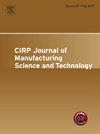Crack elimination and synergistic improvement of strength and ductility in directed energy deposited IN738 superalloy via substrate heating and heat treatment
IF 5.4
2区 工程技术
Q2 ENGINEERING, MANUFACTURING
CIRP Journal of Manufacturing Science and Technology
Pub Date : 2025-09-03
DOI:10.1016/j.cirpj.2025.08.009
引用次数: 0
Abstract
During the directed energy deposition (DED) process of IN738 superalloy, elevated thermal stresses and low-ductility γ′ phase can lead to crack formation. To tackle the cracking issue, this study developed a substrate heating platform within the DED apparatus, raising the substrate temperature to 300 °C to diminish the temperature gradient and thermal stress, while also optimizing laser power and scanning speed to achieve DED crack-free IN738. On-site thermal imaging and numerical simulations indicated that the temperature gradient and thermal stress in the samples gradually diminished with rising substrate temperatures and optimized process parameters. Moreover, microstructural characterization results revealed that heating the substrate to 300 °C reduced the content of the γ′ phase, while optimizing process parameters further refined the grains. The combination of reduced thermal stress, grain refinement, and diminished γ′ phase volume fraction collectively enabled the DED of crack-free IN738. On the crack-free DED IN738, a solution treatment at 1120°C for two hours notably improved its mechanical properties. The solution treatment simultaneously eliminated the Laves phase and generated finer γ′ phases along with a bimodal structure. These strengthening mechanisms effectively enhanced strength and ductility. Digital image correlation (DIC) and fractographic analyses substantiated that the solution treatment improved the coordinated deformation ability and the solubility of certain carbides reduced defects, further enhancing strength and ductility. Interestingly, a subsequent 24-hour aging treatment at 850°C did not significantly improve properties due to γ′ phase coarsening and δ phase precipitation.
通过基体加热和热处理消除IN738定向能高温合金的裂纹并协同提高其强度和塑性
在IN738高温合金定向能沉积(DED)过程中,较高的热应力和低塑性γ′相可导致裂纹的形成。为了解决裂纹问题,本研究在DED设备内开发了衬底加热平台,将衬底温度提高到300 °C,以减小温度梯度和热应力,同时优化激光功率和扫描速度,以实现DED无裂纹IN738。现场热成像和数值模拟结果表明,随着衬底温度的升高和工艺参数的优化,样品中的温度梯度和热应力逐渐减小。此外,显微组织表征结果表明,将衬底加热到300 °C降低了γ′相的含量,同时优化工艺参数进一步细化了晶粒。热应力的降低、晶粒的细化和γ′相体积分数的降低共同使IN738的DED无裂纹。对无裂纹DED IN738进行1120℃固溶处理2小时,其力学性能得到显著改善。固溶处理同时消除了Laves相,生成了更细的γ′相和双峰结构。这些强化机制有效地提高了强度和延展性。数字图像相关(DIC)和断口分析证实,固溶处理提高了合金的协调变形能力,某些碳化物的溶解度降低了缺陷,进一步提高了合金的强度和塑性。有趣的是,随后在850℃下进行24小时时效处理,由于γ′相粗化和δ相析出,性能没有显著改善。
本文章由计算机程序翻译,如有差异,请以英文原文为准。
求助全文
约1分钟内获得全文
求助全文
来源期刊

CIRP Journal of Manufacturing Science and Technology
Engineering-Industrial and Manufacturing Engineering
CiteScore
9.10
自引率
6.20%
发文量
166
审稿时长
63 days
期刊介绍:
The CIRP Journal of Manufacturing Science and Technology (CIRP-JMST) publishes fundamental papers on manufacturing processes, production equipment and automation, product design, manufacturing systems and production organisations up to the level of the production networks, including all the related technical, human and economic factors. Preference is given to contributions describing research results whose feasibility has been demonstrated either in a laboratory or in the industrial praxis. Case studies and review papers on specific issues in manufacturing science and technology are equally encouraged.
 求助内容:
求助内容: 应助结果提醒方式:
应助结果提醒方式:


